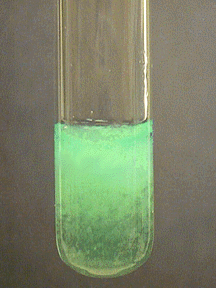The Reaction With Dmg Gives: [ni(dmg)2]2+(aq)
Confirmation Tests NiNH 3 6 2 aq 2C 4 H 8 N 2 O 2 s Nidmg 2s 4NH 3 aq 2NH 4 aq from AA 1. Study Resources. Main Menu; by School. (aq) + 2C 4 H 8 N 2 O 2 (s) → Ni(dmg) 2(s) + 4NH 3 (aq) + 2NH 4 + (aq). Which of the following reactions is a precipitation reaction a 2Al s Fe 2 O 3s. Ni(OH) 2 (s) + 2 H + (aq) Ni 2+ (aq) + 2 H 2 O (l) HNO 3 dissolves the precipitate to form a green solution of Ni 2+ ion. 25% ethylenediamine sol. Ni 2+ (aq) + 3 en (aq) Ni(en) 3 2+ (aq) A soluable purple colored complex is formed. 1% dimethylgloxime sol. Ni(en) 3 2+ (aq) + 2 DMG -(aq) Ni(DMG) 2 (s) + 3 en (aq) The bright red Ni(DMG) 2 precipitate is formed. S H aq Cu 2 aq 2H 2 O l 19 M NaOH 6 M HNO 3 Cu 2 aq OH aq CuOH 2 s Excess CuOH from CHEM 203 at University of Illinois, Urbana Champaign. (aq) + H 2 S (aq) No reaction Confirmation Test Ni 2+ (aq) + 2 DMG.
DMG helps to strengthen the immune response when the body is confronted by foreign antigens and microorganisms. It supports the production of intracellular glutathione and SAMe, and supplies methyl groups for the building and normal detoxification processes of many bodily constituents (like neurotransmitters, hormones, vitamins, etc.). Dmg formula. Through its ability to lower lactic acid build-up, DMG is known to support stamina.
Minecraft mods mac. Done!
| Names | |
|---|---|
| IUPAC name | |
Other names
| |
| Identifiers | |
| |
| ChEMBL | |
| ChemSpider |
|
| ECHA InfoCard | 100.002.201 |
| EC Number | |
PubChemCID | |
| RTECS number |
|
| UNII | |
| |
| |
| Properties | |
| C4H8N2O2 | |
| Molar mass | 116.120 g·mol−1 |
| Appearance | White/Off White Powder |
| Density | 1.37 g/cm3 |
| Melting point | 240 to 241 °C (464 to 466 °F; 513 to 514 K) |
| Boiling point | decomposes |
| low | |
| Structure | |
| 0 | |
| Hazards | |
| Main hazards | Toxic, Skin/Eye Irritant |
| Safety data sheet | External MSDS |
| GHS pictograms | |
| GHS Signal word | Danger |
| H228, H301 | |
| P210, P240, P241, P264, P270, P280, P301+310, P321, P330, P370+378, P405, P501 | |
| NFPA 704 (fire diamond) | |
| Related compounds | |
| Hydroxylamine salicylaldoxime | |
Except where otherwise noted, data are given for materials in their standard state (at 25 °C [77 °F], 100 kPa). | |
| verify (what is ?) | |
| Infobox references | |
Dimethylglyoxime is a chemical compound described by the formula CH3C(NOH)C(NOH)CH3. Its abbreviation is dmgH2 for neutral form, and dmgH for anionic form, where H stands for hydrogen. This colourless solid is the dioxime derivative of the diketone butane-2,3-dione (also known as diacetyl). DmgH2 is used in the analysis of palladium or nickel. Its coordination complexes are of theoretical interest as models for enzymes and as catalysts. Many related ligands can be prepared from other diketones, e.g. benzil.
Preparation[edit]

Dimethylglyoxime can be prepared from butanone first by reaction with ethyl nitrite to give biacetyl monoxime. The second oxime is installed using sodium hydroxylamine monosulfonate:[1]
Complexes[edit]
Dimethylglyoxime is used to detect and quantify nickel, which forms the bright red complex nickel bis(dimethylglyoximate) (Ni(dmgH)2). The reaction was discovered by L. A. Chugaev in 1905.[2]
Cobalt complexes have also received much attention. In chloro(pyridine)cobaloxime[3] the macrocycle [dmgH]22− mimics the macrocyclic ligand found in vitamin B12.

References[edit]
The Reaction With Dmg Gives Ni(dmg)2 2+(aq)
- ^Semon, W. L.; Damerell, V. R. (1930). 'Dimethylglyoxime'. Organic Syntheses. 10: 22. doi:10.15227/orgsyn.010.0022.CS1 maint: multiple names: authors list (link)
- ^Lev Tschugaeff (1905). 'Über ein neues, empfindliches Reagens auf Nickel'. Berichte der Deutschen Chemischen Gesellschaft. 38 (3): 2520–2522. doi:10.1002/cber.19050380317.
- ^Girolami, G. S.; Rauchfuss, T.B.; Angelici, R. J. (1999). Synthesis and Technique in Inorganic Chemistry: A Laboratory Manual (3rd ed.). pp. 213–215.